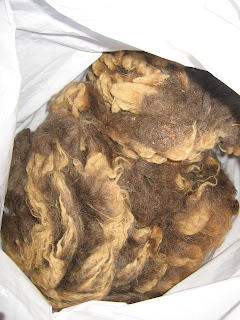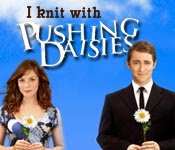The spring is a really bad time to be all resolved about not buying another fleece. I mean, shearing just started. (I'm betting at this point all of you can guess what happened.) Julia, a woman in my spinning and knitting guilds, sent out a message to the spinning guild saying she sheared and had fleeces available. I was going to resist until a) I remembered that Julia coats her sheep, b) she has CVMs and Cormos and c) I saw the pictures. I mean, how can you resist
that? (Sorry, everything is sold now.) This one is the one I bought. I seem to be going through a dark fleece stage.
Romeldale/CVM or California Variegated Mutant is a very interesting breed of sheep. According to the
American Livestock Breeds Conservancy,
"The Romeldale is an American fine wool breed, and the California Variegated Mutant, or CVM, is its multi-colored derivative. Both the CVM and the Romeldale are unique to the United States and are endangered." Romeldale sheep are usually white in color. The CVM emerged when lambs with color started showing up in the Romeldale flock and then Glen Eidman, the original breeder, started breeding for that color mutation. If you would like more information about the history of the breed,
this website is very good. The
National CVM Conservancy reports that there are fewer than 500 registered CVMs. Interestingly enough, as the sheep gets older, its colors become darker rather than lighter like most other breeds. Julia also said the fleeces get softer. Keep in mind, sticking your hand in one is like petting a cloud (albeit a cloud with hand softening lanolin but you get my point) so it is hard to imagine how the fleece could get even softer. ***eta: I just listened to the
18th episode Yarn Spinner's Tales podcast from August '08 (I'm catching up!) and she mentioned the CVM/Romeldale in her sheep breed segment. It was a very informative segment because she also talked about spinning from prepared top as well as processing a pound of raw fleece. She also had more information about the breed history than I've written here.
Cormos are another interesting breed. They originated in Australia and are a cross of Corriedale and Merino. The breed's name is also a mix of
Corriedale and
Merin
o. These sheep are soft and have a micron count of 17-23. What's a micron count you might ask? Well, get ready for a slightly technical discussion. Listening to Yarn Spinner's Tales and researching for this post has definitely been informative.
This blog has a very good post about micron counts and Bradford counts. I'm going to be quoting from it for the following information. "One micron is equal to 1/1000 of a millimeter. This means that if the micron count is being used as the system of measurement, a lower number means a finer fleece." Bradford counts, on the other hand, "measures the fineness of a fiber by determining the maximum number of 560 yard skeins that can be spun from one pound of combed fiber." To me, that one seems a little bit more problematic/objective.
Now, you might be wondering, OK, what does this all mean? Well, it gives you an idea how fine the CVM and Cormo fleeces from Julia's flock are. Merino is a good comparison because many people know what that nice wear-next-to-your-skin fiber feels like. The Merino is known for its fine, soft fleece and "has a Bradford count of approximately 60-70, and a micron count of about 24-18." CVM has a Bradford count of ~60-64 and a micron count of ~22-25. Cormo has a Bradford count of and a micron count of 17-23. My Shetland fleeces, on the other hand, have a Bradford count of 50-60 and a micron count of 20-30. The Jacobs have a Bradford count of 44-56 and a micron count of 28-39. Before the Jacob felt soft but I'm guessing that, after working with the CVM, it is going to feel extremely scratchy!



 You would not believe how soft this stuff is. I can't wait to spin some up!
You would not believe how soft this stuff is. I can't wait to spin some up!





















